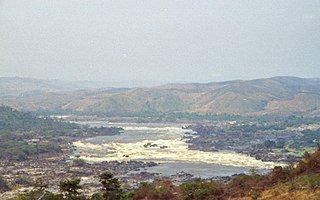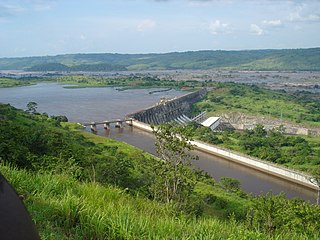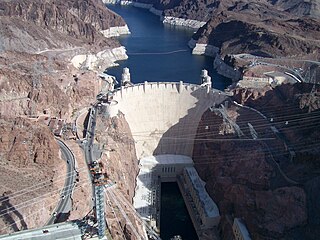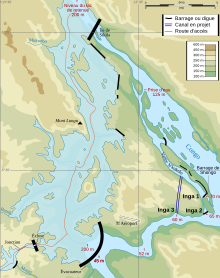
The Congo River, formerly also known as the Zaire River, is the second-longest river in Africa, shorter only than the Nile, as well as the third-largest river in the world by discharge volume, following the Amazon and Ganges rivers. It is the world's deepest recorded river, with measured depths of around 220 m (720 ft). The Congo-Lualaba-Chambeshi River system has an overall length of 4,700 km (2,900 mi), which makes it the world's ninth-longest river. The Chambeshi is a tributary of the Lualaba River, and Lualaba is the name of the Congo River upstream of Boyoma Falls, extending for 1,800 km (1,100 mi).

Hydroelectricity, or hydroelectric power, is electricity generated from hydropower. Hydropower supplies one sixth of the world's electricity, almost 4,500 TWh in 2020, which is more than all other renewable sources combined and also more than nuclear power. Hydropower can provide large amounts of low-carbon electricity on demand, making it a key element for creating secure and clean electricity supply systems. A hydroelectric power station that has a dam and reservoir is a flexible source, since the amount of electricity produced can be increased or decreased in seconds or minutes in response to varying electricity demand. Once a hydroelectric complex is constructed, it produces no direct waste, and almost always emits considerably less greenhouse gas than fossil fuel-powered energy plants. However, when constructed in lowland rainforest areas, where part of the forest is inundated, substantial amounts of greenhouse gases may be emitted.

Livingstone Falls, named for British explorer David Livingstone, are a succession of enormous rapids on the lower course of the Congo River in west equatorial Africa, downstream from Malebo Pool in the Democratic Republic of the Congo.

The Inga–Shaba EHVDC Intertie is a 1,700 kilometres (1,100 mi)-long high-voltage direct current overhead electric power transmission line in the Democratic Republic of Congo, linking the Inga hydroelectric complex at the mouth of the Congo River to mineral fields in Shaba (Katanga). It was primarily constructed by Morrison-Knudsen International, an American engineering company, with the converter equipment supplied by ASEA. Construction was completed in 1982 and it cost US$900 million. The scheme was, for many years, the longest HVDC line in the world.

Inga Falls is a rapid 40 km from Matadi in the Democratic Republic of the Congo where the Congo River drops 96 m (315 ft) over the course of 15 km (9 mi). The falls are part of a larger group of rapids in the lower Congo River. Livingstone Falls are located upstream closer to the Pool Malebo. These falls have formed in a sharp bend of Congo River where the width of river fluctuates from more than 4 km to only 260 m.

The Inga Dams are two hydroelectric dams connected to one of the largest waterfalls in the world, Inga Falls. They are located in the western Democratic Republic of the Congo and 140 miles southwest of Kinshasa.
The Western Power Corridor (Westcor) was a project to construct and supply energy from two hydroelectric power plants to the Democratic Republic of the Congo, Angola, Namibia, Botswana and South Africa. Originally, the hydro power was to be supplied form the Democratic Republic of the Congo's INGA III project. Later Inga III was supposed to be replaced by Angola's Cuanza River and Cunene River projects or by the new project in the Democratic Republic of Congo.

The Democratic Republic of the Congo was a net energy exporter in 2008. Most energy was consumed domestically in 2008. According to the IEA statistics the energy export was in 2008 small and less than from the Republic of Congo. 2010 population figures were 3.8 million for the RC compared to CDR 67.8 Million.

Hydroelectricity is, as of 2019, the second-largest renewable source of energy in both generation and nominal capacity in the United States. In 2021, hydroelectric power produced 31.5% of the total renewable electricity, and 6.3% of the total U.S. electricity.
The Lake Chad replenishment project is a proposed major water diversion scheme to divert water from the Congo River basin to Lake Chad to prevent it drying up. Various versions have been proposed. Most would involve damming some of the right tributaries of the Congo River and channeling some of the water to Lake Chad via a canal to the Chari River basin.
The Rusumo Hydroelectric Power Station, also known as the Rusumo Power Station, is a hydropower plant under construction, with initial planned capacity installation of 80 megawatts (110,000 hp) when completed. The project will involve the construction of a dam, with run of river design. A more expensive 90 megawatts (120,000 hp) reservoir design was considered before being abandoned in favor of an 80 MW project with a smaller environmental impact and an estimated cost of US$300 million compared to US$400 million for the bigger project. The World Bank announced on 6 August 2013 that it had approved loans totaling US$340 million towards the US$468.60 million needed for the project. In November 2013, the African Development Bank approved a loan of US$113 million towards completion of the project.
Ruzizi IV Hydroelectric Power Station, is a proposed hydro-power plant, with planned capacity installation of 287 megawatts (385,000 hp) when completed.
The Bundi River is a river of the Democratic Republic of the Congo. It is a right tributary of the lower Congo River that enters the river below the Inga Falls. If the proposed Grand Inga Dam project goes ahead, the river valley will be flooded to form a huge lake.
Nseke Hydroelectric Power Station is an operational hydropower plant in the Democratic Republic of the Congo, with installed capacity of 260 megawatts (350,000 hp). It is operated by the Congolese electricity utility company, Société Nationale d'Électricité (SNEL).
Grand Katende hydroelectric power station is a hydropower plant under construction in the Democratic Republic of the Congo, with installed capacity of 64 megawatts (86,000 hp). When completed, it will be operated by the Congolese electricity utility company, Société Nationale d'Électricité (SNEL).
The Zongo II Power Station, also Zongo 2 Power Station, is a hydroelectric power station across the Inkisi River that harnesses the energy of the Zongo Falls in the Democratic Republic of the Congo. Construction began on 14 March 2012 and concluded in 2018. The power station was officially inaugurated on 22 June 2018 by the President of the DR Congo, at that time, Joseph Kabila.
The Liouesso Hydroelectric Power Station is a 19.2 megawatts (25,700 hp) hydroelectric power station in the Republic of the Congo. The government-owned power station was commercially commissioned in May 2017. Constructed by the China Gezhouba Group, the renewable energy infrastructure project cost approximately US$110 million to construct.









